Ecuaciones para la estimación del agua corporal total por el método de análisis de impedancia bioeléctrica a 50 kHz
Palabras clave:
agua corporal total, impedancia bioeléctrica, método de Bland-Altman.Resumen
Introducción: El agua mantiene un rango normal en personas aparentemente sanas, el cual se altera ante la existencia de diversas enfermedades.
Objetivo: Conocer cuánto se diferencian los valores de agua corporal total estimados por las ecuaciones de agua corporal total, de Kushner, de Deurenberg y de Heitman, con respecto a los obtenidos clínicamente por el método de impedancia bioeléctrica a 50 kHz.
Métodos: Se realizó un estudio descriptivo y transversal, de abril a diciembre del 2018, en 62 individuos: 31 adultos aparentemente sanos y 31 niños y adolescentes con diferentes enfermedades, ingresados en el Hospital Infantil Docente Sur Dr. Antonio María Béguez César de Santiago de Cuba (24 en el Servicio de Misceláneas y 7 en el de Oncopediatría). El agua corporal total y los parámetros bioeléctricos se estimaron con el analizador de impedancia bioeléctrica Bodystat® 1500-MDD, a 50 kHz, por el método tetrapolar ipsilateral derecho. Se utilizó el criterio de Bland-Altman, para un 95 % de confianza, a fin de conocer si las ecuaciones de Kushner, de Deurenberg y de Heitman podían sustituir a la ecuación de referencia.
Resultados: Las ecuaciones de agua corporal total, de Kushner y de Deurenberg no mostraron diferencias significativas respecto a la ecuación de referencia, mientras que la ecuación de Heitman sí presentó diferencias significativas en relación con el resto de las ecuaciones. El método de Bland-Altman demostró que la ecuación de Kushner posee mayor concordancia con la ecuación de referencia.
Conclusiones: La ecuación de Kushner es la de mayor exactitud para la estimación del agua corporal total en personas sanas y en las afectadas por entidades clínicas.
Descargas
Citas
2. Matias C, Santos D, Júdice P, Magalhães J, Minderico C, Fields D, et al. Estimation of total body water and extracellular water with bioimpedance in athletes: A need for athlete-specific prediction models. Clin Nutr. 2016;35(2):468-74.
3. El-Sharkawy AM, Opinder S and Lobo DN. Acute and chronic effects of hydration status on health. Nutrition Reviews. 2015;73(suppl 2):97-109.
4. Khalil S, Mohktar M, Ibrahim F. The Theory and Fundamentals of Bioimpedance Analysis in Clinical Status Monitoring and Diagnosis of Diseases. Sensors. 2014;14(6):10895-928.
5. Park JH, Jo YI, Lee JH. Clinical usefulness of bioimpedance analysis for assessing volume status in patients receiving maintenance dialysis. Korean J Intern Med. 2018;33(4):660-9.
6. Malczyk E, Dziegielewska-Gesiak S, Fatyga E, Ziółko E, Kokot T, Muc-Wierzgon M. Body composition in healthy older persons: Role of the ratio of extracellular/total body water. J Biol Regul Homeost Agents. 2016; 30:767–72.
7. Buendia R, Seoane F, Lindecrantz K, Bosaeus I, Gil-Pita R, Johannsson G, et al. Estimation of body fluids with bioimpedance spectroscopy: state of the art methods and proposal of novel methods. Physiol Meas. 2015;36:2171-87.
8. Malbrain ML, Huygh J, Dabrowski W, DeWaele JJ, Staelens A, Wauters J. The use of bio-electrical impedance analysis (BIA) to guide fluid management, resuscitation and deresuscitation in critically ill patients: A bench-to-bedside review. Anaesthesiol Intensive Ther. 2014;46:381–91.
9. Morales González M, Verdecia Jarque M, Rubio González T, Bergues Cabrales LE, Lara Lafargue A, Martínez Tassé JP. Influencia de la resistencia eléctrica en la estimación del agua corporal total y la masa libre de grasa. MEDISAN. 2013 [citado 14/10/2018];17(10):7002-11. Disponible en: http://scielo.sld.cu/scielo.php?script=sci_arttext&pid=S1029-30192013001000012
10. Lara Lafargue A, Bergues Cabrales LE, Verdecia Jarque M, Laurencio Martínez Y, Ortega Díaz Y. Parámetros bioeléctricos in vitro e in vivo, estimados con los analizadores Bodystat® 1500-MDD y BioScan® 98. MEDISAN. 2013 [citado 14/10/2018];17(9):4054-63. http://scielo.sld.cu/scielo.php?script=sci_arttext&pid=S1029-30192013000900001
11. Asociación Médica Mundial. Declaración de Helsinki de la AMM- Principios éticos para la investigación en seres humanos. New York: AMM; 2017 [citado 14/10/2018]. Disponible en: https://www.wma.net/es/policies-post/declaracion-de-helsinki-de-la-amm-principios-eticos-para-las-investigaciones-medicas-en-seres-humanos/
12. Brantlov S, Ward L, Jødal L, Rittig S, Lange A. Critical factors and their impact on bioelectrical impedance analysis in children: a review. J Med Eng Technol. 2017;41(1):22-35.
13. Savegnago M, Faccioli J, Jordao A. Analysis of Body Composition: A Critical Review of the Use of Bioelectrical Impedance Analysis. Int J Clin Nutr. 2014;2(1):1-10.
14. Lukaski HC. Evolution of bioimpedance: a circuitous journey from estimation of physiological function to assessment of body composition and a return to clinical research. Eur J Clin Nutr. 2013;67(1):2-9.
15. Essa’a VJ, Dimodi HT, Ntsama PM, Nama G. Validation of anthropometric and bioelectrical impedance analysis (BIA) equations to predict total body water in a group of Cameroonian preschool children using deuterium dilution method. Nutrire. 2017;42:20.
16. Wickramasinghe V, Cleghorn G, Davies P. Assessment of body composition of Sri Lankan Australian children using ethnic specific equations. Indian J Nat Sci Foundation Sri Lanka. 2015; 43(2):111-8.
17. Lingwood BE. Bioelectrical impedance analysis for assessment of fluid status and body composition in neonates-the good, the bad and the unknown. Eur J Clin Nutr. 2013;67(suppl 1):28-33.
18. National Institutes of Health. Technology Assessment Conference Statement. Bioelectrical impedance analysis in body composition measurement. Am J Clin Nutr. 1996;64(3):524-32.
19. Seoane F, Abtahi S, Abtahi F, Ellegård L, Johannsson G, Bosaeus I, et al. Mean expected error in prediction of total body water: A true accuracy comparison between bioimpedance spectroscopy and single frequency regression equations. Bio Med Res Int. 2015 [citado 14/10/2018];5. Disponible en: http://downloads.hindawi.com/journals/bmri/2015/656323.pdf
20. Lukaski HC, Kyle UG, Kondrup J. Assessment of adult malnutrition and prognosis with bioelectrical impedance analysis: phase angle and impedance ratio. Curr Opin Clin Nutr Metab Care. 2017;20:330–9.
Publicado
Cómo citar
Número
Sección
Licencia
Esta revista provee acceso libre e inmediato a su contenido bajo el principio de que hacer disponible gratuitamente investigación al público, apoya aún más el intercambio de conocimiento global. Esto significa que los autores/as conservarán sus derechos de autor y garantizarán a la revista el derecho de primera publicación de su obra, el cuál estará simultáneamente sujeto a la licencia internacional Creative Commons Atribución 4.0 que permite copiar y redistribuir el material en cualquier medio o formato para cualquier propósito, incluso comercialmente, además de remezclar, transformar y construir a partir del material para cualquier propósito.





